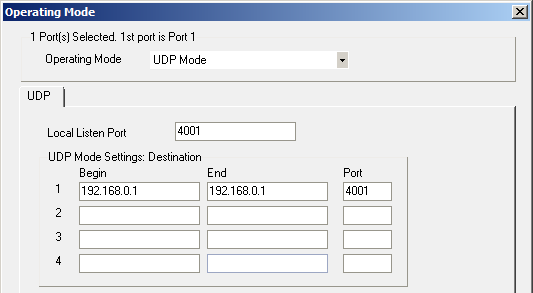...
SerialOverUDP Device Redundant, SerialOverUDP Line Redundant, and SerialOverUDP System&Line Redundant communication lines were designed for support of "Serial to Ethernet Device Servers" of (e.g. Moxa NPort serial devices). These devices are powerful compact converters of RS232/422/485 interfaces to the TCP/IP Ethernet which support work in UDP mode. These devices transmit data, received from serial lines, to UDP packets, and send them to one or more IP addresses and ports (where the D2000 KOM process is located). Likewise, the serial device server sends data, which have been received on a specific UDP port, to a serial port.
The transmission parameters of the serial line are set in the configuration of the serial device and cannot be changed or set via configuration in the D2000 System. Data, transmitted in UDP packets between the device and D2000 KOM, contain only data of the serial communication. They contain neither the control nor the check characters (e.g. handshaking).
Note: Both IPv4 and IPv6 protocols are supported.
Note: An RFC2217 Client line can be used to control the parameters of the serial line if the serial server supports the RFC2217 mode.
...
It is a UDP port, to which the KOM process is bound and where the data from the serial server is received. Local Port must correspond to the serial server configuration (the parameter Port in the line where the IP address with the KOM process is set). A local UDP port must be unique, neither another line nor any application (out of the D2000 System) can use it on a computer where the D2000 KOM process is running.
...
IP address or hostname of a serial server. It is a UDP port that receives the data transmitted by the D2000 KOM process. The Port value must correspond to the (Moxa NPort or other) serial server configuration (the parameter "Local Listen Port").
Note: it is possible to specify an address * or ALL (for IPv4 protocol) or [*] or [ALL] (for IPv6 protocol) that causes data to be received from any device, but sending data is disabled. This feature is useful e.g. in combination with the Generic User Protocol.
...
IP address or hostname of a backup serial server. It is a UDP port that receives the data transmitted by the D2000 KOM process. The Port value must correspond to the (Moxa NPort or other) serial server configuration (the parameter "Local Listen Port" parameter ).
The Serial Device Redundancy and D2000 System Redundancy
...
Some of the communication protocols support support D2000 System Redundancy where there are more instances of the KOM process (KOM process on HOT server and KOM process on SBS server). In that case, a communication process connected to the SBS server never sends data and doesn't interfere with the communication of the KOM process connected to the HOT server. It only listens to and processes the data received from the serial server. If it is possible, it analyzes these data.
...
A primary device is used after starting the KOM process in case of the redundant configuration of the serial servers. A backup device starts to work when no message with data has been detected from the primary device within a defined timeout (a default value is 15 seconds, but it can be changed for some of the protocols in the protocol parameters). All requests start to be sent to the backup device. If the communication via the backup device works, the primary device is not checked anymore. If the communication with a backup device fails, it will be switched back to the primary device. Basically, the devices always switch after the detection of the communication error on the working device.
...
This is a simple connection of the NPort device which replaces an asynchronous serial port directly in the PC. No redundancy is used including NPort devices, D2000 System, and network interfaces.
...
- TCP/IP network: 192.168.0.0/16
- The IP address of the NPort serial device: 192.168.0.50
- The IP address of the D2000 server with the KOM process: 192.168.0.1.
...
Operating Mode dialog box - the configuration of the NPort serial device:
Port 4001 was chosen for the Local Listen Port. Data are sent to D2000 KOM process 192.168.0.1, which uses also the local port 4001. We recommend using the same port number within the configuration of one communication line.
...
Both NPort devices (primary and secondary one) are set in the D2000 communication line configuration:
...
| Kotva | ||||
|---|---|---|---|---|
|
...
This line is like a quasi "dualdoubled" SerialOverUDP Device Redundant line. It is intended for communication protocols with transmission via two redundant physical transmission lines. For the configuration of this line category, the same rules apply as for the configuration of the the SerialOverUDP Device Redundant line.
| Kotva | ||||
|---|---|---|---|---|
|
...
This line is like a "doubled" double line of "SerialOverUDP Line Redundant". It is specially used for communication protocols with transmission towards two remote systems, two redundant physical transmission lines to each (or a single remote system with four lines). For the configuration of this line category, the same rules apply as for the configuration of the the SerialOverUDP Device Redundant line.
...
